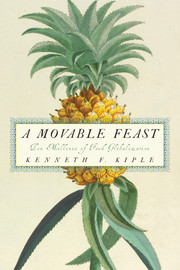Book contents
- Frontmatter
- Contents
- Preface
- Acknowledgments
- INTRODUCTION: FROM FORAGING TO FARMING
- Ch. 1 LAST HUNTERS, FIRST FARMERS
- Ch. 2 BUILDING THE BARNYARD
- Ch. 3 PROMISCUOUS PLANTS OF THE NORTHERN FERTILE CRESCENT
- Ch. 4 PERIPATETIC PLANTS OF EASTERN ASIA
- Ch. 5 FECUND FRINGES OF THE NORTHERN FERTILE CRESCENT
- Ch. 6 CONSEQUENCES OF THE NEOLITHIC
- Ch. 7 ENTERPRISE AND EMPIRES
- Ch. 8 FAITH AND FOODSTUFFS
- Ch. 9 EMPIRES IN THE RUBBLE OF ROME
- Ch. 10 MEDIEVAL PROGRESS AND POVERTY
- Ch. 11 SPAIN'S NEW WORLD, THE NORTHERN HEMISPHERE
- Ch. 12 NEW WORLD, NEW FOODS
- Ch. 13 NEW FOODS IN THE SOUTHERN NEW WORLD
- Ch. 14 THE COLUMBIAN EXCHANGE AND THE OLD WORLDS
- Ch. 15 THE COLUMBIAN EXCHANGE AND NEW WORLDS
- Ch. 16 SUGAR AND NEW BEVERAGES
- Ch. 17 KITCHEN HISPANIZATION
- Ch. 18 PRODUCING PLENTY IN PARADISE
- Ch. 19 THE FRONTIERS OF FOREIGN FOODS
- Ch. 20 CAPITALISM, COLONIALISM, AND CUISINE
- Ch. 21 HOMEMADE FOOD HOMOGENEITY
- Ch. 22 NOTIONS OF NUTRIENTS AND NUTRIMENTS
- Ch. 23 THE PERILS OF PLENTY
- Ch. 24 THE GLOBALIZATION OF PLENTY
- Ch. 25 FAST FOOD, A HYMN TO CELLULITE
- Ch. 26 PARLOUS PLENTY INTO THE TWENTY-FIRST CENTURY
- Ch. 27 PEOPLE AND PLENTY IN THE TWENTY-FIRST CENTURY
- Notes
- Index
Ch. 11 - SPAIN'S NEW WORLD, THE NORTHERN HEMISPHERE
Published online by Cambridge University Press: 22 August 2009
- Frontmatter
- Contents
- Preface
- Acknowledgments
- INTRODUCTION: FROM FORAGING TO FARMING
- Ch. 1 LAST HUNTERS, FIRST FARMERS
- Ch. 2 BUILDING THE BARNYARD
- Ch. 3 PROMISCUOUS PLANTS OF THE NORTHERN FERTILE CRESCENT
- Ch. 4 PERIPATETIC PLANTS OF EASTERN ASIA
- Ch. 5 FECUND FRINGES OF THE NORTHERN FERTILE CRESCENT
- Ch. 6 CONSEQUENCES OF THE NEOLITHIC
- Ch. 7 ENTERPRISE AND EMPIRES
- Ch. 8 FAITH AND FOODSTUFFS
- Ch. 9 EMPIRES IN THE RUBBLE OF ROME
- Ch. 10 MEDIEVAL PROGRESS AND POVERTY
- Ch. 11 SPAIN'S NEW WORLD, THE NORTHERN HEMISPHERE
- Ch. 12 NEW WORLD, NEW FOODS
- Ch. 13 NEW FOODS IN THE SOUTHERN NEW WORLD
- Ch. 14 THE COLUMBIAN EXCHANGE AND THE OLD WORLDS
- Ch. 15 THE COLUMBIAN EXCHANGE AND NEW WORLDS
- Ch. 16 SUGAR AND NEW BEVERAGES
- Ch. 17 KITCHEN HISPANIZATION
- Ch. 18 PRODUCING PLENTY IN PARADISE
- Ch. 19 THE FRONTIERS OF FOREIGN FOODS
- Ch. 20 CAPITALISM, COLONIALISM, AND CUISINE
- Ch. 21 HOMEMADE FOOD HOMOGENEITY
- Ch. 22 NOTIONS OF NUTRIENTS AND NUTRIMENTS
- Ch. 23 THE PERILS OF PLENTY
- Ch. 24 THE GLOBALIZATION OF PLENTY
- Ch. 25 FAST FOOD, A HYMN TO CELLULITE
- Ch. 26 PARLOUS PLENTY INTO THE TWENTY-FIRST CENTURY
- Ch. 27 PEOPLE AND PLENTY IN THE TWENTY-FIRST CENTURY
- Notes
- Index
Summary
… Christopher Columbus began a process that in the words from a passage in one of the books of Esdras … “Shook the earth, moved the round world, made the depths shudder and turned creation upside down.”
Eugene Lyon (1992)IN THE AMERICAS, Spain and Portugal laid claim to a vast storehouse of strange new plant foods. In the West Indies – the gateway to Spain's Americas – a sampling of the groceries that greeted Columbus and his men included zamia (Zamia integrifolia), manioc (Manihot esculenta), and maize (Zea mays) – these used for breads and gruels. Then there were myriad other mysterious vegetables like sweet potatoes (Ipomoea batatas), yautía (Xanthosoma sagittifolium), beans (genus Phaseolus), and peanuts (Arachis hypogaea). New seasonings were encountered, such as allspice (Pimenta dioica) and chilli peppers (genus Capsicum), along with indigenous West Indies fruits such as guava (Psidium guajava), soursop (Annona muricata), mamey (Mammea americana), custard apple (Annona reticulata), sapodilla (Achras zapota), pawpaw (Carica papaya), and pineapple (Ananas comosus). And these were just a few of the American foods that Europeans had never before laid eyes on nor set tooth to.
Fish and mollusks had provided much of the animal protein for those South American Tainos who had settled in the Greater Antilles and the Bahamas, but sea turtles and their eggs, land crabs (Cardisoma sp.), insects, and small game such as the iguana (family Iguanidae) – which became extinct in the West Indies after the Europeans arrived – also made contributions.
- Type
- Chapter
- Information
- A Movable FeastTen Millennia of Food Globalization, pp. 105 - 112Publisher: Cambridge University PressPrint publication year: 2007

